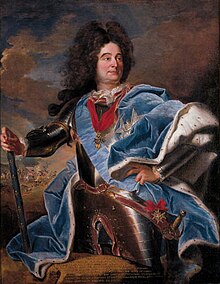Rhine campaign of 1713
| Rhine campaign (1713) | |||||||
|---|---|---|---|---|---|---|---|
| Part of War of the Spanish Succession | |||||||
 Marshal Claude Villars | |||||||
| |||||||
| Belligerents | |||||||
|
|
| ||||||
| Commanders and leaders | |||||||
|
|
| ||||||
| Strength | |||||||
|
115 squadrons 85 battalions |
300 squadrons 240 battalions | ||||||
| Casualties and losses | |||||||
| unknown | unknown | ||||||
The Rhine campaign (1713) was a successful French campaign against the Holy Roman Empire, which refused to sign the Treaty of Utrecht. The campaign led to the signing of the Treaty of Rastatt (1714).
Prelude
On 11 April 1713, the Treaty of Utrecht was signed between most participants in the War of the Spanish Succession: Spain and France against Great Britain, Portugal, Savoy and the Dutch Republic. The Habsburg Monarchy and the Holy Roman Empire refused to sign the treaty and so remained at war against France.
Campaign
By 1713, both France and the Holy Roman Empire were militarily depleted, but France was able to raise the largest army, with 300 squadrons and 240 battalions. Command of the army was given to Marshal Villars, the most successful French army commander of the war.
Eugene of Savoy moved all of his forces from the Spanish Netherlands to the upper Rhine to co+operate with the armies of the other German states. Now that the subsidies of the Maritime powers had ceased, the armies of the Holy Roman Empire were very much below strength. The combined army of Eugene of Savoy had only 115 squadrons and 85 battalions, more or less one third of the strength of the French army.
The French army crossed the Rhine in June and the Marquis de Bezons started to besiege Landau on June 24. The city, defended by Charles Alexander, Prince of Württemberg, held out until August 26 before it surrendered. In the meantime, Arthur Dillon had also taken Kaiserslautern.
Villars then advanced to besiege Freiburg on September 20. The city surrendered on October 15 and the castle on November 17. Eugene of Savoy could not risk battle and was reduce to the role of passive spectator.
Louis XIV now asked to open negotiations and was accepted by the Holy Roman Empire. Marshal Villars and Prince Eugene of Savoy met in the city of Rastatt in Baden-Baden and started a series of complex negotiations which lasted until 7 March 1714, when the Treaty of Rastatt was signed.
